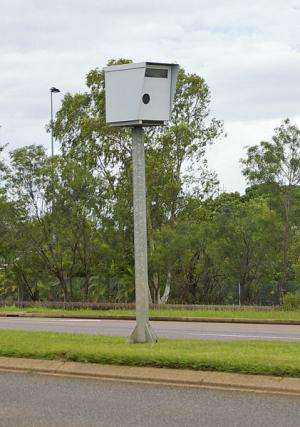Can you drive fast enough to avoid being clocked by speed cameras?

Anyone wanting to avoid being caught out by speed cameras can do so very simply - by obeying the speed limits.
But University of Leicester physics students have suggested that - theoretically, at least - there may also be another way of avoiding getting a ticket.
A group of four MPhys students found that drivers could escape detection by driving so fast that their number plates would appear invisible to speed cameras.
But any drivers tempted to give this a try next time they are on the motorway should be warned; the car would need to be travelling at 119 million miles per hour to make the number plate invisible.
This speed equates to one sixth of the speed of light – and no man-made vehicle is capable of going anywhere near this speed.
So – for all concerned – it's still best to stick to the speed limit.
The students made the calculations in their final year paper for the Journal of Physics Special Topics, a peer-reviewed student journal run by the University's Department of Physics and Astronomy.
Their calculation is based on the Doppler Effect – the physical effect where the frequencies of light or sound waves emanating from an object increase or decrease when it moves towards or away from you.
This effect is at work when you hear an ambulance – its siren will appear to lower in pitch as it drives past you.
With light, this process creates "red shift" – where the frequency of light from an object travelling away from the observer is shifted towards the red end of the colour spectrum. The faster an object is travelling, the bigger the shift in frequency.
This means it would theoretically be possible for the light from a fast-moving car number plate to be shifted out of the frequency range which speed cameras are able to detect.
The group assumed the camera would be able to detect a similar frequency range as the human eye – roughly 400 terahertz at the "red" end of the spectrum to 790 terahertz at the violet end.
Car number plates are generally yellow – which has a frequency of around 515 terahertz.
To work out the necessary speed of the car for the number plate to be "shifted" past the 400 terahertz boundary of the visible spectrum, the group utilised the equation used by astronomers to calculate how fast stars are travelling away from the Earth.
They found the car would need to be travelling at 53 million metres per second – equal to 119 million miles per hour, or one sixth of the speed of light.
Given that the fastest man-made object – the Helios Probe – is only capable of travelling at one five thousandth of the speed of light, we clearly have some way to go before we would ever be able to see this effect in action.
Student Dan Worthy, 21, from Chelmsford, Essex, said: "It would be great fun if we could become invisible - but unfortunately our current technology isn't advanced enough to do this.
"I would like to think that in the future, when we can travel between stars, intergalactic speed cameras would need to look for invisible spaceships too."
"The Doppler Effect is something most people learn in GCSE physics, but we thought it would be good to look at what day-to-day effects it could have.
"Our message to drivers is that it would be completely pointless to try to use this method to avoid a speeding ticket."
Course tutor Dr Mervyn Roy, a lecturer in the University of Leicester's Department of Physics and Astronomy, said: "The aim of the module is for the students to learn about peer review and scientific publishing.
"The students are encouraged to be imaginative with their topics, and find ways to apply basic physics to the weird, the wonderful and the everyday."
More information: The paper is available online: physics.le.ac.uk/journals/inde … article/view/681/460
Journal information: Journal of Physics Special Topics
Provided by University of Leicester





















